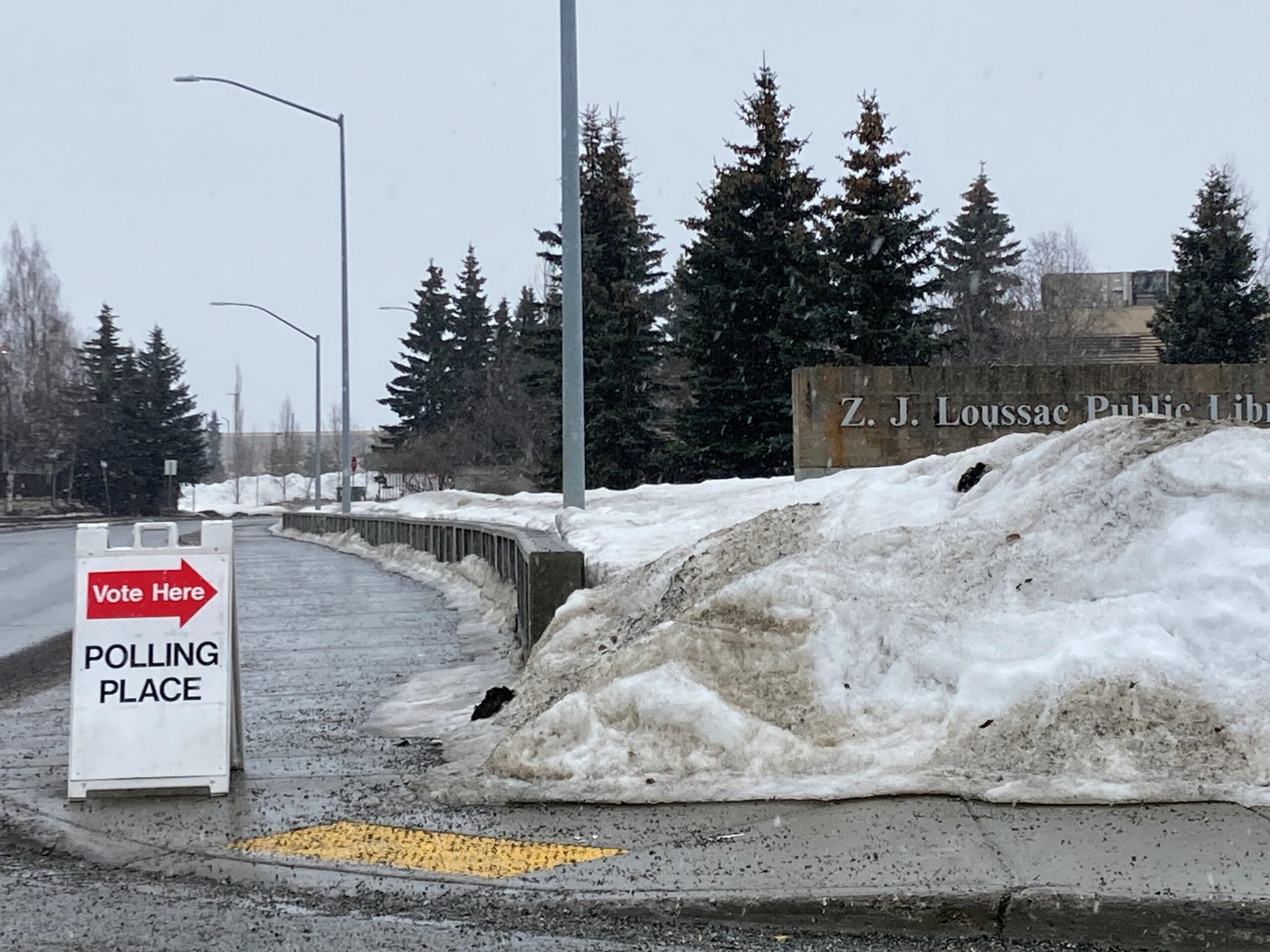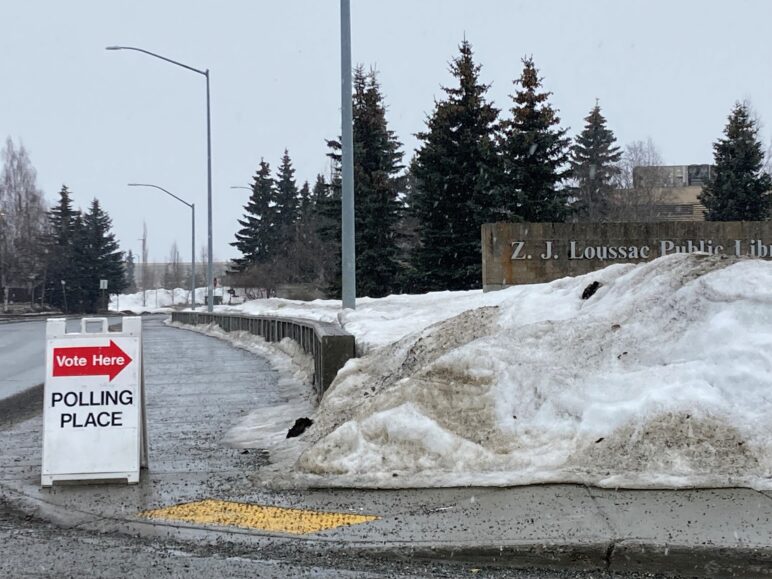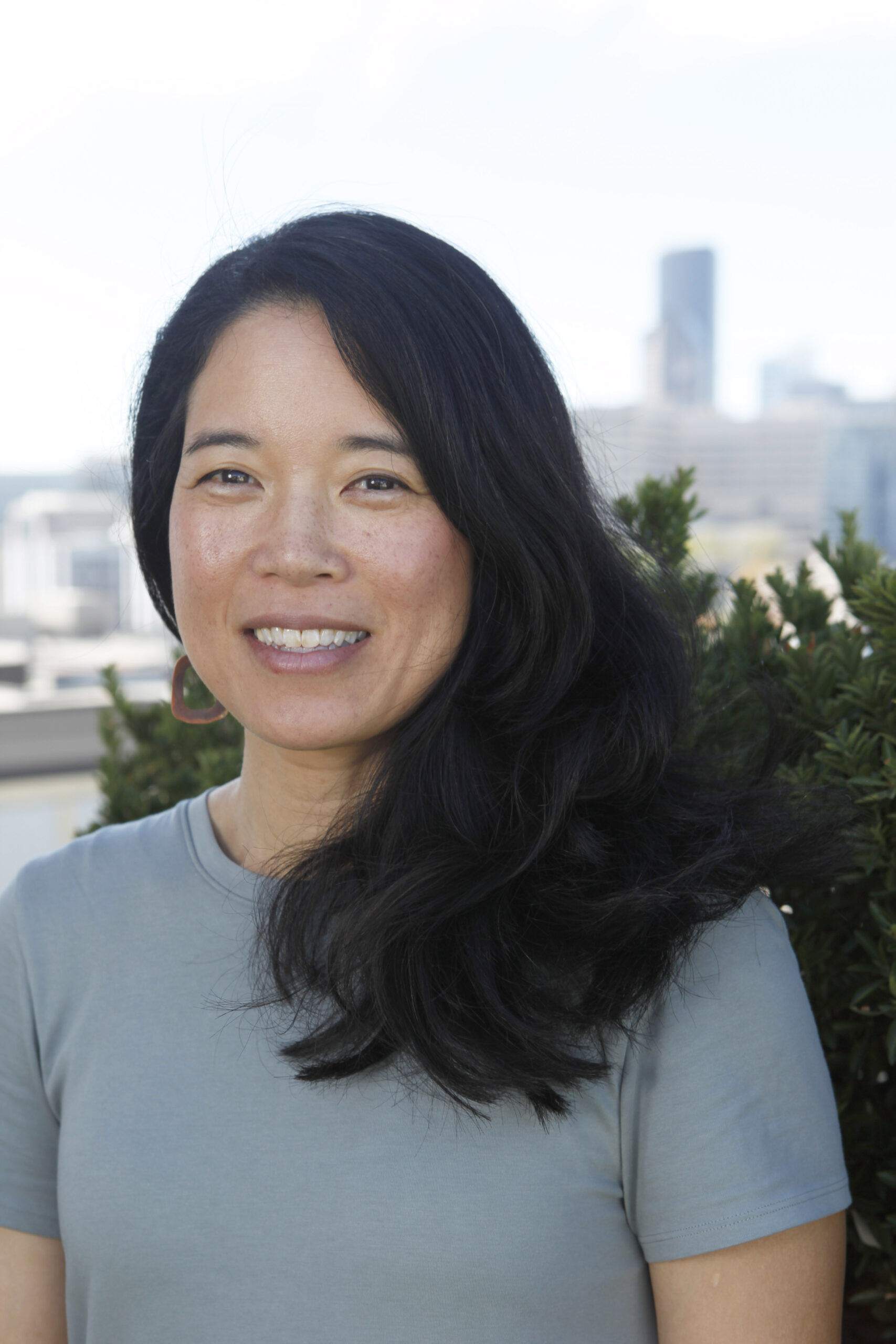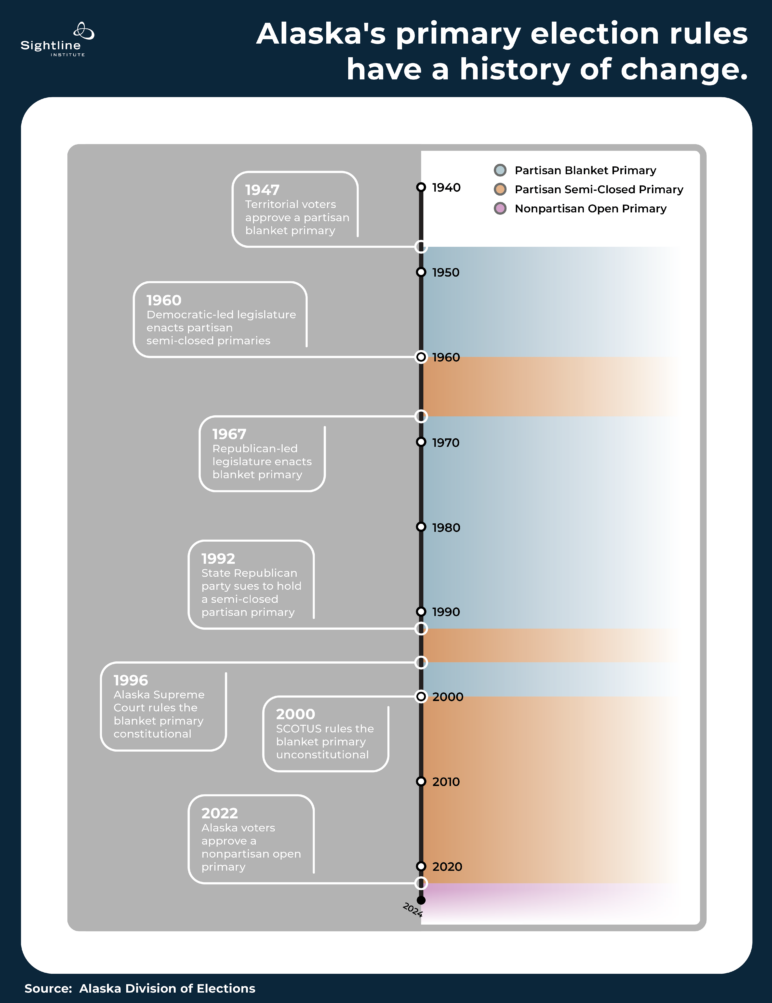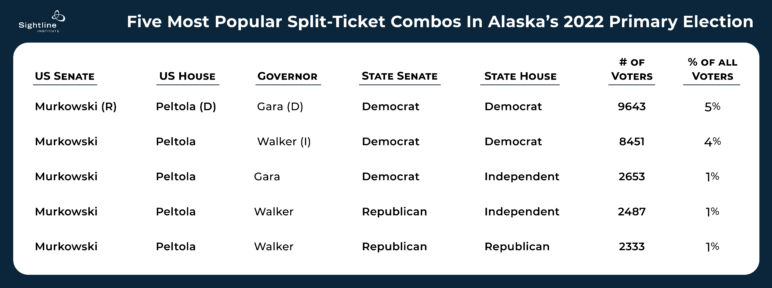In 2022, Alaska voters for the first time used nonpartisan open primaries to choose candidates for the general election. Every voter, regardless of political registration, received the same ballot. And every ballot listed every candidate in every race. In this style of primary, voters could support a mix of Republicans, Democrats, independents, and third-party candidates, or they could vote along party lines.
Our analysis of 2022 primary election data found slightly more than half of Alaska’s 192,061 voters1 opted to split their tickets in the races for US Senate, US House, governor, and state legislative offices. The combinations of candidates spanned the political spectrum, which was unsurprising given that Alaska has the highest percentage of independent voters in the nation.
The cast vote record from the Alaska Division of Elections shows what combination of candidates each Alaska primary voter chose. From this data, we cross-referenced candidates’ self-described political affiliations to determine how many Alaskans split their ticket between candidates of different parties.
One of the more popular multipartisan combos, chosen by 24,350 voters, was an independent gubernatorial candidate, a Republican for US Senate, and a Democrat for US House. Less conventional combinations also surfaced. For instance, 5,606 Alaskans voted for Republicans in the three statewide races and chose at least one Democrat to serve in the legislature. And very small numbers of voters simultaneously supported conservative and progressive candidates whose platforms appear to have little overlap.
The debut in August 2022 of nonpartisan open primaries brought voters unaffiliated with either party closer to squaring their numbers with their political clout. Lawmakers from the two major parties dominate Alaska’s political scene, yet only 37 percent of registered voters in the 2022 primary belonged to the Democratic or Republican parties. Nearly two-thirds of Alaska voters were (and continue to be) independents, a combination of nonpartisan and undeclared voters. The chance to express independent political preferences is a defining feature of Alaska’s open primary system. All Alaskans, whether party-registered or not, are free to look beyond party when deciding which candidates they want to see in the general election.
Alaska’s primary election rules have a history of change
Since statehood, Alaska has vacillated between so-called “blanket” primaries and semi-closed primaries. From 2004–2020, the two major parties settled into a pattern for organizing their primaries. Republicans held semi-closed primaries, meaning only Republican and independent voters could participate, but not Democrats and those registered with third parties. Democrats and third parties offered a combined ballot open to all registered voters.
In Alaska’s 2022 nonpartisan open primaries, though, all candidates appeared on a single ballot available to all voters, regardless of party. Allowing all voters the chance to vet all candidates in a state-funded election made sense. Voters could pick one candidate per race to advance to the general election. The top four vote-getters in each race then moved on to the ranked choice general election. The open primaries apply to races for governor, US Senate, US House, and both chambers of the Alaska legislature. They do not apply to the presidential primaries, which are funded by political parties.
Notably, 49 percent of all voters chose a Republican in at least one race and a candidate of a different party in another contest. The old Republican primary rules forced voters to choose from a menu of Republican candidates only, making such combinations impossible.
Notably, 49 percent of all voters chose a Republican in at least one race and a candidate of a different party in another contest. The old Republican primary rules forced voters to choose from a menu of Republican candidates only, making such combinations impossible. When given the chance to choose candidates freely, tens of thousands of Alaska primary voters did just that.
A majority of Alaska’s primary voters chose a mix of candidates from different parties
About 52 percent of Alaska’s 192,061 primary voters crossed party lines in the 2022 primaries. Another 44 percent voted an all-Republican ticket. Voters were far less likely to toe the Democratic party line, with just 4 percent casting all-blue ballots.
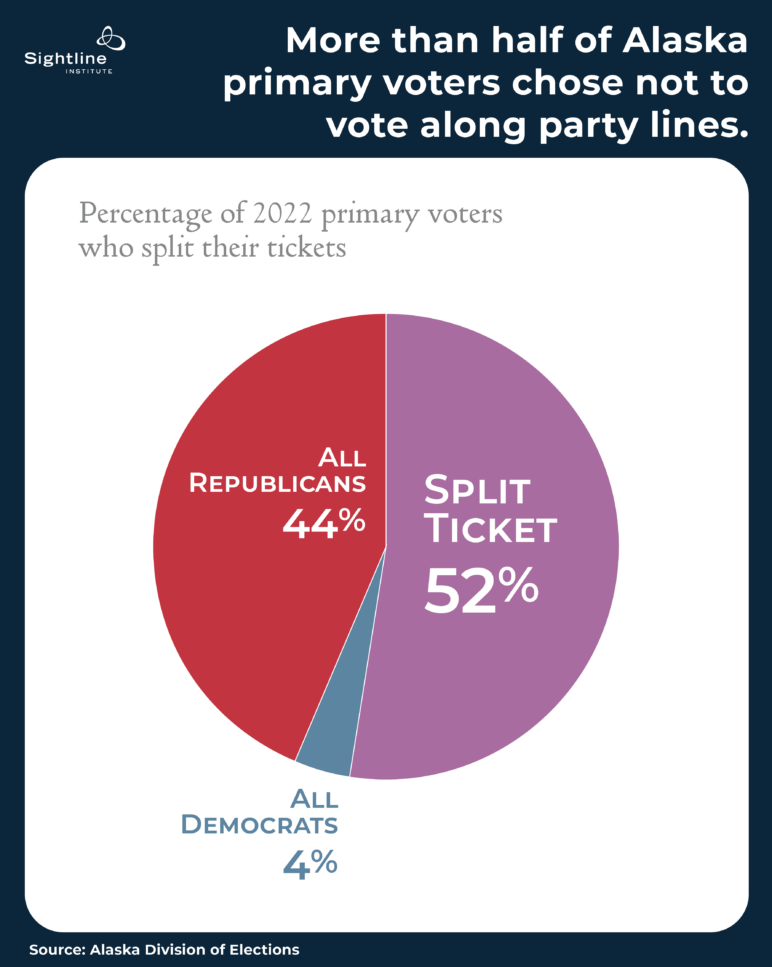
Within the group of split-ticket voters, 44 percent voted multipartisan. That is, they supported candidates from both major parties, plus independent and/or third-party candidates. Another 31 percent voted for candidates from the two major parties, but no independent or third-party candidates. The rest of the voters who split their tickets opted for only one major party but were willing to also vote independent and/or third-party.
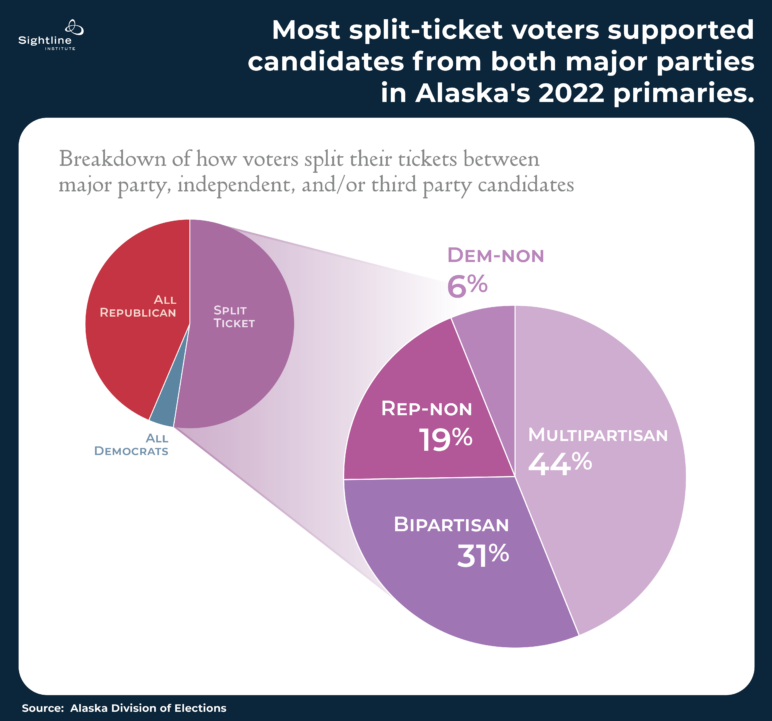
Many Alaska voters hold more complex political views than a straight party ticket would allow them to express. For example, left-leaning voters might have supported incumbent conservative Governor Mike Dunleavy for maintaining the Permanent Fund Dividend, a no-strings-attached annual cash payout to every Alaskan. Right-leaning voters might have gone in for Rep. Mary Peltola, the pro-oil moderate Democrat who vowed to continue the legacy of Rep. Don Young, the Republican Congressman whose seat she won. And voters have an established history of pan-partisan support for Sen. Lisa Murkowski, a Republican and one of the few remaining moderates in Congress.
Though we can see how Alaskans voted, the ballot data from the Division of Elections reveal nothing about the voters themselves. Thus, there is no information about how many registered Republicans and Democrats split their tickets for independent candidates or, conversely, how many independents voted straight party tickets.
Alaska ballot data reveal unconventional combinations of candidates
Political combinations spanned various flavors of conservative to moderate Republican, to multipartisan ballots that included independents, to straight Democratic tickets. As the only major independent candidate, former Governor Bill Walker was a big driver of primary ticket-splitting. About 41,800 ticket-splitters, accounting for 22 percent of all primary voters, chose Walker plus candidates from major and third parties.
Voters submitted more than 7,500 different candidate combinations, including ballots where voters chose not to vote in one or more races. The most common ticket-splitting combination across all five races accounted for about 5 percent of all primary voters: Murkowski, a Republican, for US Senate; Peltola for US House; Democrat Les Gara for governor; plus Democrats for state House and Senate. The same combo, but with Walker for governor, accounted for 4 percent of all ballots.2
Notably, contradictory combinations that seemed to defy all political logic and would have been impossible under the previous party-controlled primary system showed up in the ballot data. For example, a tiny bloc of 3,100 Dunleavy-Peltola voters exists. Open primaries gave them the chance to vote for a Trump-supporting conservative for governor and a moderate Democrat for US House.
Another 1,517 Alaskans voted straight Republican in every statewide race and straight Democrat in the legislative races. On the flip side, 494 went for Democrats across the statewide offices and for Republicans in both legislative races. Another 82 voters chose conservative Kelly Tshibaka, who ran to the right of Murkowski for US Senate, along with Democrats Peltola and Gara for House and governor respectively. On balance, these numbers are miniscule, but they underscore the extraordinary power voters gain by way of nonpartisan primaries to express their political preferences.
Lack of political diversity among candidates in some legislative races meant some voters had no choice but to split their tickets. In 19 of the 59 state Senate and House primaries, only one party or political group was represented. The three contenders for Kodiak’s Senate District C, for example, were all Republicans: Heath Smith, Walter Jones, and Gary Stevens. (Stevens would go on to win and serve as Senate President.) The same happened in House Districts 17 and 19 in Anchorage, where two Democrats, but no other candidates, ran in each race.
Still, most voters in districts with only one political choice for legislature chose to split their tickets in other races that included candidates from across the spectrum. Only 5 percent of all voters selected candidates from the same party up and down the ballot, save for a legislative race where no candidate from that party ran.
Under the old system, registered Democrats and Republicans in legislative primaries without a candidate from their party would have been completely locked out from weighing in on who should advance to the general election. In Alaska’s nonpartisan primary system, Democrats could choose their favorite (or least disliked) Republican. And Republicans faced with a slate of Democrats could do the same.
Alaska’s nonpartisan open primaries helped balance the state’s political leadership
The 2022 election results in Alaska wouldn’t have been particularly remarkable in the 1990s. Back then, fewer than 20 states elected governments controlled exclusively by a single party, meaning both chambers of the legislature and the governorship, according to Ballotpedia. But today, despite more Americans than ever identifying as independent, a single party controls the governorship, state House, and state Senate in all but 10 states.
Alaska is one of the shrinking number of states with a surviving multipartisan government. Bipartisan majority coalitions lead both the House and Senate in the 60-member state legislature. And open primaries helped propel the largest number of independents into the state legislature in history by removing the barriers for them to run against major party candidates. The statewide winners similarly reflect Alaska’s multipartisan political culture. Gov. Dunleavy is one of the most conservative governors in the country. US Sen. Murkowski is an independent-leaning Republican. US Rep. Peltola is a moderate Democrat.
Alaska’s previous semi-closed primary model sent candidates on to the general election who weren’t always as popular with the whole electorate. It denied voters the chance to consider candidates who enjoyed more widespread support. Allowing all Alaska voters to give every candidate equal consideration in the primaries appeared to lay the foundation for a more politically diverse and less partisan set of leaders. Other states looking to ensure full participation for independent voters, improve fairness in primary elections, and give voters more choice and influence may find some inspiration here.
Correction: A previous version of this article stated that there were 39 Alaska state Senate and House races in the 2022 midterm elections. The correct number is 59.

